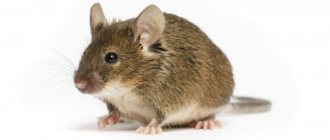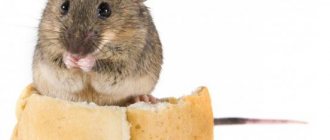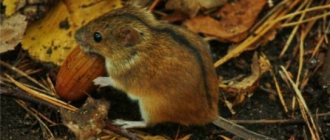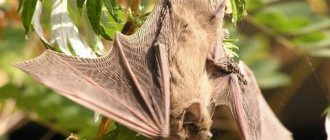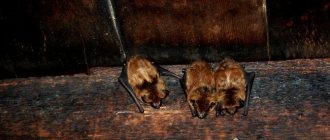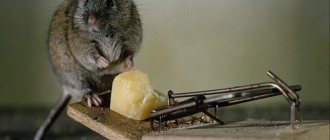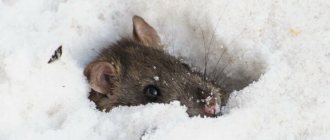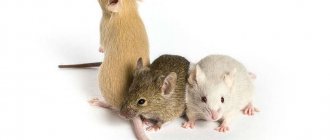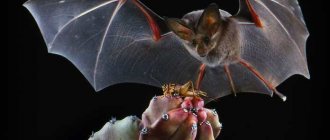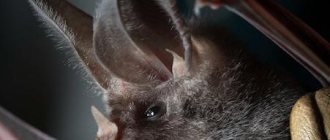Views: 81
House mice are one of the most common problems that residents have to deal with when it comes to rodents. These nimble critters cause a lot of trouble by damaging furniture, eating and contaminating food, chewing wires and sharpening their incisors on interior items. In other words, mice in the house are an unpleasant phenomenon.
In this article we will look at what mice look like, where they live and settle, how they get into the house, what they eat, how quickly mice multiply in the house and some other points.
Photos of mice and their appearance
It is worth immediately noting that different species and subspecies of the mouse family can differ greatly from each other. On average, these are quite small animals. Body length, as a rule, is no more than 10 cm. More often less.
The length of the scaly tail also varies among different species. Thus, there are representatives whose tail is equal to 3/4 of the length of the rodent’s body (75%). These include the species Mus musculus. In others (for example, Mus domesticus), the tail length exceeds the body size. These are the so-called long-tailed mice.
The coloring is also extremely varied. From light sandy to dark, almost black, including all transition colors with shades of gray and brown. In this case, the color can be either uniform or variegated. The abdomen of adults, as a rule, is noticeably lighter - from white to dirty yellow and gray. Small mice are more uniform in color.
The weight of an adult animal most often does not exceed 30 g. And even then these are already giants in the mouse world. The ears are round in shape. The head has a triangular outline.
Wool
The creature, based on the descriptions of different species, also differs in color. In 75% of cases, the mammal is gray, dark gray, or brown. This coloring helps to hide from predators and makes them invisible at night.
Mexican piscivorous species have yellow or orange fur. Some species are light yellow in color. Representatives of Honduras are albinos with yellow ears and nose.
The body and head are covered with fur. The wings are bare, with soft skin. This feature also applies to young nocturnal animals. The fur can be thick or sparse, with long or short pile. The habitat of the species plays a role here.
Interesting fact! There really is a vampire bat. But it feeds exclusively on the blood of small animals. It poses no danger to humans, even if she is very hungry. Maximum harm from flyers: babies fly poorly, so a collision may occur. Only the cub suffers from such blows.
Distribution of house mice
All these animals belong to synanthropic pests, that is, those that exist directly next to humans. At the same time, mice found in the house, or so-called house mice, combine several species. Some of them are more common in Russia and Eastern Europe. This is Mus musculus. Others prefer to settle in overseas countries. These include the species Mus domesticus. These rodents are native to the Middle East, most of Africa, Europe and America. They are also common in Australia.
A species of brownish mouse, Mus castaneus, is found in Asia. They settle only in human buildings. The short-tailed mice, Mus spretus and Mus macedonicus, live in the Mediterranean. The last two species are more wild living, although they can coexist with humans.
These are just some species from the large mouse family, representatives of which can be found in human homes. Different mice in the house differ from each other in color and other external characteristics, as well as climate preferences. Some people feel more comfortable in drier areas. Others, on the contrary, settle where there is high humidity.
But one way or another, all the mice spread throughout the world along with people. They followed the man to the territories he inhabited. At the same time, the animals used any transport that allowed them to move to new habitats. These include steamships, merchant ships, trains, freight trains, cars, airplanes and any luggage that a person uses to carry things. So the tailed critters eventually conquered almost the entire world.
Where do furry rodents live?
In fact, it's easier to say where they don't live. Mice are cosmopolitan. This means that they are distributed throughout the globe. The only obstacle to their life is extremely low temperatures. Therefore, they cannot be found in areas covered with eternal ice. They are also absent on snowy mountain peaks, as well as in frozen, deserted taiga or tundra.
Animals cannot live in the plagues of northern peoples. But on the islands in the middle of the seas and oceans, mice settled down quite happily. Rodents arrived on the oceanic islands along with merchant and passenger ships. And due to their unpretentiousness and adaptability, they became permanent members of the local fauna.
It is worth noting that even in warm countries there are species of mice that live exclusively in human dwellings. They are so connected to human society. And since in these areas the climate is favorable for their development and reproduction, mice in the house there are a common occurrence.
But in more northern latitudes, rodents do not just like to live in heated dwellings. Human homes are often the only way for them to survive. Although with the onset of warmer seasons, many of them can migrate into the natural environment. In summer, such nomads settle in more natural habitats, although they stay near crops, vegetable gardens and orchards. And only in the far north are rodents completely attached to humans all year round. Constant unfavorable climatic conditions in these areas do not allow them to develop wild, uninhabited areas of nature.
Distribution in Russia
In Russia, house mice are most often found . They live in all corners of the country, with the exception of the northeastern part of Siberia, the interfluve of the Lena and Yenisei rivers and mountain forests. Several species of voles live in the European part of Russia.
Baby mice prefer warm climates . Their habitat includes the coasts of the Black and Baltic seas, the Caucasus, Transbaikalia, and the Volga coast. Field mice live in the southern part of Western Siberia and the Caucasus.
How do mice get into the house?
It must be said that there are almost no barriers for these little critters. At the same time, they are very inventive in their methods of penetration. And yet, it is still surprising to meet them, for example, on the upper floors of high-rise buildings. So how do they get there?
Therefore, it is all the more necessary to know the main ways mice enter the house. To be able to resist their invasion. The most common are the following:
- Tree branches located close to the building.
- Other plants wrapping around the façade of the building.
- Rough external walls of the house. Mice can climb up them quite easily.
- Open windows, doors, balconies.
- All kinds of through holes in the house - both those that appeared over time and those that were not sealed during construction.
- Garbage chute inside the house.
- Ventilation system with open exits to apartments.
- New household items brought into the apartment from outside, including furniture, things, food products.
Knowing these “weak” points, it is easier to take preventive and exterminatory measures against mouse colonies. Especially if they become regulars.
At the same time, invaders can be either individuals or live in families. Such groups usually consist of one male, several females and a large younger generation. Adult cubs are often expelled from the colony, forcing them to develop unoccupied territories and spread wider.
Where do mice settle in the house?
Living inside houses, furry tenants sometimes show amazing ingenuity. Thus, some nests were found in flower pots, under the roots of plants. Others were found inside upholstered furniture. Deposits of clothes, forgotten shoes, and cluttered shelves are also suitable for their existence. Mice make their home wherever they are not disturbed.
That is why it is very important for preventive purposes to keep the house clean and tidy. Like many other pests, house mice primarily live among clutter and trash. They feel comfortable and calm there. And it’s not so easy to evict them from there. We still have to sort out the rubble.
At the same time, rodents use all their extraordinary physical abilities to search for suitable places. For example, animals easily and very skillfully climb up almost smooth surfaces. When necessary, they make impressive leaps from one surface to another if there is no other way to get where they need to go. Tailed critters are also excellent at diving downwards. Landing from a height, even many times their size, does not cause them any problems. Having touched the ground, the agile animals continue on their way as if nothing had happened.
To build nests in the house, mice use any available material. It can be newspaper, paper, cardboard, sawdust, fabric, cotton wool, straw and much more. Whatever the nosy animals can get their hands on. Thus, in virtually any conditions they can settle down very comfortably.
Although, of course, most often mice in the house settle near food supplies. These animals not only “clean up” everything that is in bad shape, but also tend to make numerous reserves “for a rainy day.” Therefore, they are most often caught in barns, pantries, food storage facilities, etc. Some were even caught in refrigerators. How they managed to get there remains a mystery. Apparently, the animals detected the moment when the door was open and left unattended for some time.
What do mice eat?
In terms of food, these tenants are extremely unpretentious. Although they still have certain preferences. Mice are famous grain eaters. If they have the opportunity to choose their menu, they gravitate toward cereals, flour and pasta, cereals, and all kinds of seeds. In the absence of such a choice, fruits, vegetables, pet food, meat and dairy products, etc. are used. In addition, mice in the house are also known for the fact that they can consume frankly inedible materials. For example, candle wax, wallpaper glue, starch, bars of soap, etc.
If small predators come across insects and/or their larvae, then they are not averse to eating them too. Animals do not neglect carrion. Dead representatives of the fauna also become objects of food for small rodents. If they manage to get to the birds’ nests, then they will not fail to destroy them. In this case, both eggs and newborn chicks suffer.
It should be noted that mice are carnivorous not only towards other animals. These animals are also no different in their humanity towards their fellow tribesmen. They eat both dead comrades and their young. The latter is often observed in cases where there is an overpopulation of mice in the house.
These rodents are territorial animals. This means that everyone has their own inhabited area where the animal feeds and which it fiercely guards from other invaders. If fertile females bring more offspring than can live in this territory, then the carnivorous mother often kills the little mice. A similar situation is observed when there is a shortage of feed. In addition, defenseless offspring may suffer in the event of any stressful situations that threaten the quiet life of adult mice.
Sense organs (eyes, ears and teeth)
The bat's eyesight is poor, but its ears can detect the slightest rustle several meters away. The auricle is huge.
Before flying, pushing off from the surface, the animal emits a piercing squeak, which, when it encounters an obstacle, returns. This echolocation allows one to navigate at night and serves as a technique for catching prey.
Eyes of medium size. Set on the front of the muzzle. Vision is black and white. When sunlight appears or imitates it, the bird experiences pain.
The jaw consists of incisors, molars, premolars, and canines. The pungency, shape and quantity depend on the nutrition of the chiropteran creature:
- In insectivores - 38, long, shaped like a mortar; in bloodsucking - 20-26 teeth, sharp, large on a well-developed jaw.
How quickly do mice breed in the house?
Very fast. An adult female can produce a new litter approximately every two months. An average of 5-7 mice are born at one time. However, this figure can reach up to fifteen. Especially if the female is young and full of strength, and there is enough food and space for housing.
A mother mouse carries her offspring for about three weeks. Another three weeks are needed for the cubs to become independent in obtaining food and life support. And just three months after birth (and even earlier), the grown-up pups become sexually mature individuals. They themselves begin to bear offspring. In addition to this, the female that gave birth, already within the first day after birth, is again ready for mating.
As a result, the mouse population often increases extremely quickly. In favorable conditions, for example, in residential buildings, in the presence of warmth and food, after just a couple of months a whole colony of tailed parasites appears, attacking food supplies. It is worth remembering that in greenhouse human conditions, mice in the house breed all year round, producing up to six litters.
All this suggests that it is impossible to let a mouse invasion take its course. Even one mouse can cause significant harm to residents. And what can we say about the whole family?
In the wild, things are a little different. There, mice mate and breed only in the warm months. And here a lot depends on natural conditions and the amount of food. Therefore, the offspring are usually smaller in number.
The most popular in Russia
In Russia, the most common 4 types of these rodents are: house, black, forest and field. Now in more detail about each type.
Brownies
Found everywhere. In winter, it even climbs into multi-story buildings. With such cohabitation, all furniture, wiring and food will be damaged. The dimensions are small - about 5-6 cm, the fur is gray.
Black
One of the subspecies of brownies. Lives mainly in houses. Prefers warm climates. Moves very quickly - up to 12 km/h. How many pups a mouse gives birth to depends on the size of the mother and her lifestyle. Usually this is about 7 mice.
Forest
According to the name, such a rodent lives in the forest. Mainly in burrows or trees. For wintering it digs a hole up to 2 meters deep! It is up to 10 cm in length and weighs up to 25 g. It is red or black in color. You can identify a wood mouse by its ears - they are large and round.
Field
Lives in the fields, destroying crops. Sometimes feeds on insects. The active phase occurs at night, as during the day it is pursued by predators. It has a dark brown color interspersed with black and a light belly and paws. The size reaches 11 cm, weight – up to 20 g.
How long do tailed tenants live?
Very often no more than a year. Only in human housing, under the most favorable conditions, can they live up to two years. In a human home, mice are more protected from unfavorable conditions. That's why they live longer. On the contrary, in the wild, where there are many more dangers and food is inconsistent, mouse mortality is higher and life expectancy is noticeably lower.
Moreover, females often “outlive” males. There are few long-livers among the latter. Many die before reaching the age of one year. In other words, females are more hardy and resilient in this regard.
Lifestyle of house mice
In greenhouse conditions, tailed animals are able to adapt to human living conditions. Although initially they are nocturnal animals. Rodents are most active at dusk. However, living side by side with a person, in his house, mice adapt to the human lifestyle. They act when representatives of humanity are resting) In this case, even light is not a hindrance to them.
Animals move indoors along their own paths. They mark them with urine, sweat and other excrement. Moreover, the urine of tailed pests is very concentrated and contains various pheromones. That is why, where these animals live, the air is saturated with a characteristic “mouse” smell.
Some of the pheromones perform the function of transmitting a danger signal. They are released into the urine when the animal is frightened. Once in the environment, this smell serves as an alarm signal for other mice in the house. It doesn’t matter what scared the toothy rodent. Having “read” the warning odors, the remaining members of the family begin to avoid this place. Even if there is tasty bait there)
What class of animals does a bat belong to?
A unique and at the same time terrifying creation of nature is the bat. The animal belongs to the class of chiropteran mammals. The exemplary behavior of parents will make anyone who sees the mother’s care touch. The female is capable of raising someone else's child if necessary. Zoologists call flyers altruists.
Microchiroptera became special for many reasons:
- high sensitivity to light and ultrasound; the only animals of the mammalian class that are able to fly; in the dark they develop speeds of more than 45 km/h; they have a special way of orientation at night.
Scientists have been arguing for a long time about the identity of the bat. The creature has characteristics of both animals and birds.
The role of smell in the life of small rodents
Orientation by smell is the most important for these animals. Since they lead a twilight and nocturnal lifestyle, their eyesight is weakest. The animals rely on it to the least extent. Things are a little better with the sense of touch and hearing. However, it is the olfactory organs that are decisive in their life activity, orientation in space and interaction with each other.
Based on odors, mice in the house divide the territory, marking it with their pheromones. The sense of smell helps them identify strangers and find “their own”. Little mice find their mother by smell. Males identify females, and females become ready for mating by sensing adult males. When two males meet, they begin to secrete a pheromone, which causes aggression in the opponent. This encourages them to fight each other and find out who is stronger and more important.
In other words, it is difficult to overestimate the role of olfactory receptors in the life of mice. If animals are somehow deprived of their olfactory abilities, then they will actually be doomed to death. Not only will they not be able to find food for themselves. The critters will not even understand where their territory is, where they are and where they are, who is dominant in their family, etc. Such mice will become completely defenseless and will soon simply die.
What else to read about rodents:
– Features of the life activity of the gray rat. Part 1.
– Black rat – photo, description, danger
– Deratization – what is it?
– Dangerous diseases caused by rodents
– Professional methods of rodent control
– Which rodent repeller should I choose?
